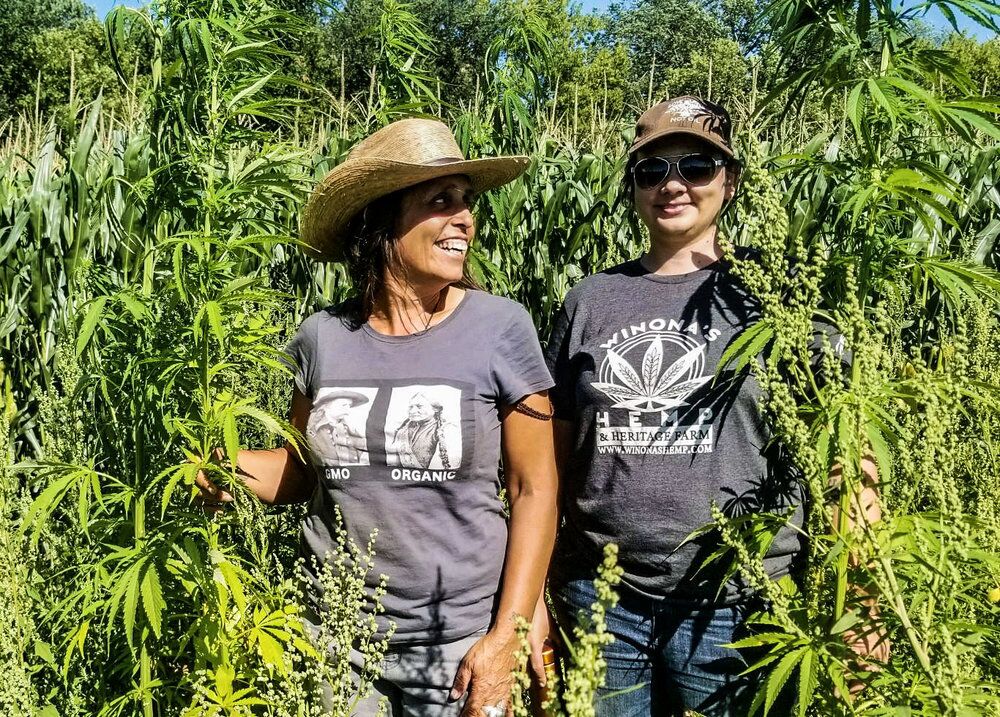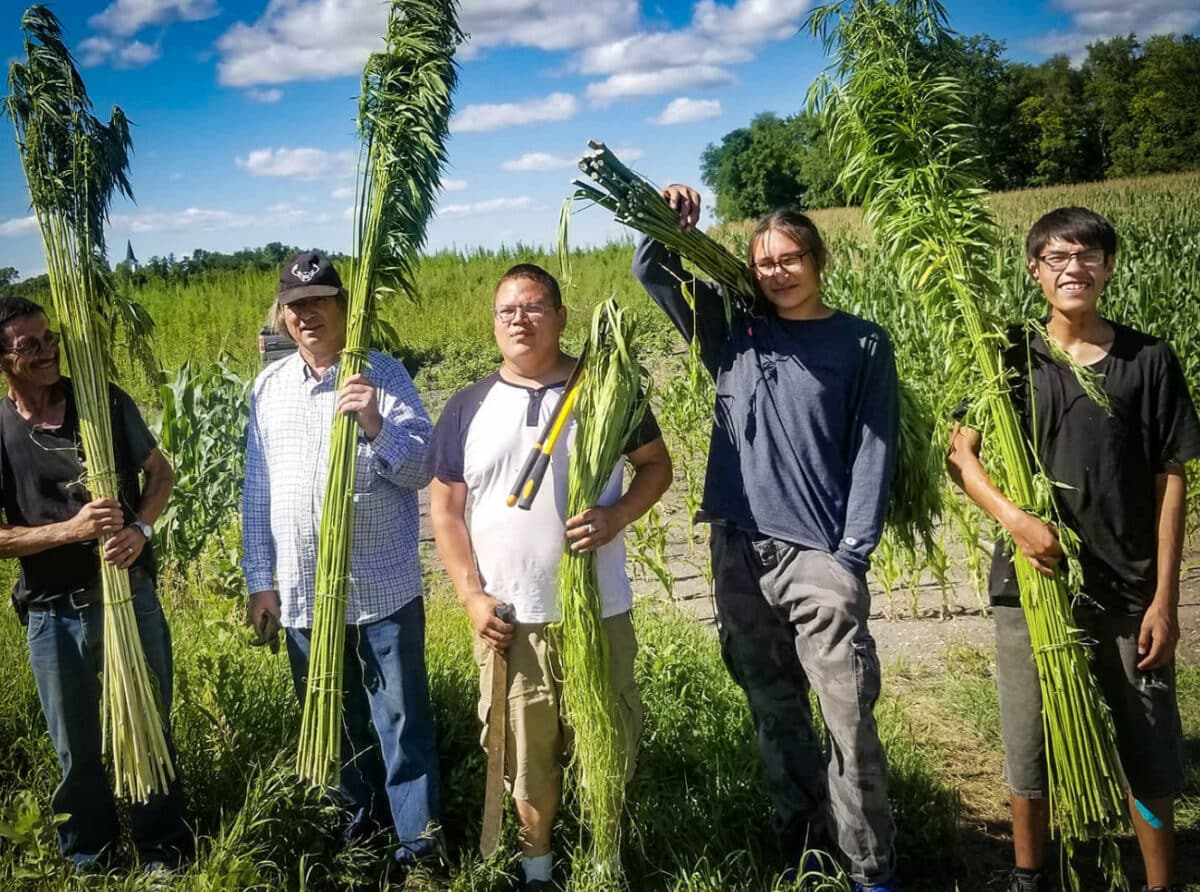On the banks of Wounded Knee Creek, a dream died in 1890 in a brutal massacre. Today, 110 years later, on that same creek, a dream was born. That’s the work that Alex White Plume, traditional leader and former tribal president of the Oglala Lakota, and his family began: the hemp economy.
For this they faced federal charges, had their crop seized and saw the frenzy of federal agents—the Drug Enforcement Administration, the FBI, the Bureau of Indian Affairs and the U.S. Marshal’s office—descend upon them. The feds are gone, but the White Plumes and their hemp field are still here. The dream was reborn.

Winona La Duke with colleague Nicolette Slagleon in 2015 on Winona’s hemp farm on the White Earth Reservation in northwestern Minnesota. (Winona’s Hemp & Heritage Farm)
Cannabis can transform our materials economy and textiles industry, return carbon to the soil, provide sustainable housing material, nurture health and well-being and set us on a path to restorative justice. That’s why we call it the New Green Revolution. We call it the “New” Green Revolution because the so-called father of the Green Revolution, Norman Borlaug, an agronomist from the University of Minnesota, brought us a lot of seeds and food but also harmful synthetic chemicals, pesticides and land consolidation and grabbing.
Now it’s time to heal up. This is a story about that potential, and how Indigenous farmers and nations are embracing this new economy.
The word canvas comes from cannabis. Let that sink in. Minnesota used to have 11 hemp mills. Those hemp mills were mostly located in southern Minnesota, the last one operating was in Winona. The robust Minnesota hemp industry was a scaled version of hundreds of years of hemp processing technology, which then added mechanization and paired hemp with other local textile plants, like flax from which linen is made. The strongest ropes in the world, the so-called “hanging ropes,” were made entirely of hemp. The last place hemp ropes were made was at Stillwater Prison in Minnesota. I figure at least one of my relatives made hemp rope.
The Future Is Cooperative Farming
Inspired by the White Plumes and the recently deceased Dakota poet and philosopher John Trudell, I started growing industrial hemp under state and federal permits in 2015, the first year it was legal in Minnesota, and founded Winona’s Hemp. I’ve farmed for 40-plus years and this was a crop of epic promise.
The tribal nonprofit research project Anishinaabe Agriculture Institute, which I founded with a group of other farmers on the White Earth Reservation in northwestern Minnesota, took up hemp research the following year.

Working in the nonprofit sector is tricky, particularly with a recently permitted plant like hemp. We began to research textile applications, which it turns out is the hardest path. Our interest: What varieties are the best? How do you grow them without chemicals? How do you process them into the durable plain-woven fabric of canvas? With the support of foundations, including Patagonia and the Lift Economy, we began our research.
We began to understand that this is a crop that requires scale. Growing marijuana (hemp’s cousin with THC) can work at small scale, with maybe seven plants for a family. With hemp, however, we are talking about thousands of acres needed to make canvas. To do this, we knew that as Native people we would need to organize Native farmers. Much of our farmland had been taken by non-Natives, and now the smatterings of remaining tribal farmland need to be coordinated.
In 2023, hemp grown by Winona’s Hemp and the Anishinaabe Agriculture Institute became what was likely the first hemp bag made in the United States for a generation or two. That bag, a $129 hemp tool bag for Patagonia, is on the market today, albeit with little credit to the farmers.
Making the bag required a multi-state effort: the hemp was grown on the White Earth Nation, decorticated in North Carolina, degummed in Virginia, spun in Mexico, woven in Washington state and cut and sewn in California. That’s a long way for hemp to travel for processing. But that’s the challenge ahead, and the times are changing.
We used to have a robust textile industry in the United States. My grandmother was a union member of the International Ladies Garment Workers Union in New York City. About 80% of clothing made domestically used to be made from hemp, until hemp was outlawed in the early 20th century.
In the push for corporate profits, much of the American textile industry was offshored during the latter part of the 20th century. According to the U.S. Department of Agriculture, from 1994 to 2005, the U.S. lost more than 900,000 textile and apparel jobs to offshoring. Most textiles today are no longer made from natural materials, they are engineered from fossil fuels. That fast fashion adds a huge carbon footprint to our world.
There is a solution: rebuild the North American textile economy with natural fibers like wool, hemp and linen. It’s time to bring the textile industry back home.
Hemp needs farmers. That’s why we started the Indigenous Hemp & Cannabis Farmers Cooperative, a group of Native farmers from the northern plains. Today we are working to support farmers across the Dakotas and Southwest to learn and grow the crop as we ready ourselves for the hemp renaissance. These farmers are following every trail and path in this country toward finding and owning hemp processing equipment with the end goal of producing canvas at a cost-effective scale.
The future is not competition, it’s cooperation.
That’s right, these farmers want to own the value-added processing equipment that will make canvas, which is used to produce all kinds of items for which sturdiness is required, even the basic home-building construction material, hempcrete. Indigenous farmers like Breon Lake, from the Sisseton Wahpeton Oyate of the Lake Traverse Reservation in South Dakota and North Dakota who runs Wacin’he Wakan Hemp, plan to grow much more hemp in their fertile soil. Together, the tribe’s farmers are building a processing cooperative.
That’s how it’s done.